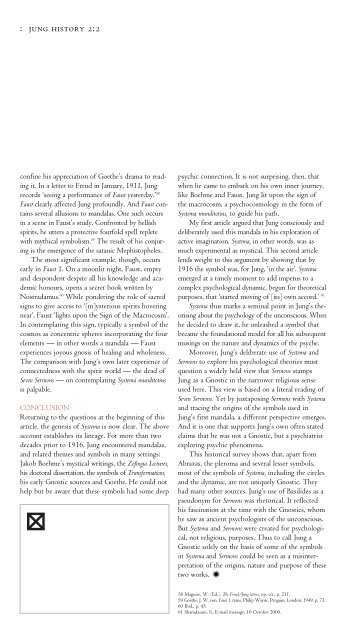a semi-annual publication of the philem n foundation - Philemon ...
a semi-annual publication of the philem n foundation - Philemon ...
a semi-annual publication of the philem n foundation - Philemon ...
Create successful ePaper yourself
Turn your PDF publications into a flip-book with our unique Google optimized e-Paper software.
: jung history 2:2<br />
confine his appreciation <strong>of</strong> Goe<strong>the</strong>’s drama to reading<br />
it. In a letter to Freud in January, 1911, Jung<br />
records ‘seeing a performance <strong>of</strong> Faust yesterday.’ 58<br />
Faust clearly affected Jung pr<strong>of</strong>oundly. And Faust contains<br />
several allusions to mandalas. One such occurs<br />
in a scene in Faust’s study. Confronted by hellish<br />
spirits, he utters a protective fourfold spell replete<br />
with mythical symbolism. 59 The result <strong>of</strong> his conjuring<br />
is <strong>the</strong> emergence <strong>of</strong> <strong>the</strong> satanic Mephistopheles.<br />
The most significant example, though, occurs<br />
early in Faust 1. On a moonlit night, Faust, empty<br />
and despondent despite all his knowledge and academic<br />
honours, opens a secret book written by<br />
Nostradamus. 60 While pondering <strong>the</strong> role <strong>of</strong> sacred<br />
signs to give access to ‘[m]ysterious spirits hovering<br />
near’, Faust ‘lights upon <strong>the</strong> Sign <strong>of</strong> <strong>the</strong> Macrocosm’.<br />
In contemplating this sign, typically a symbol <strong>of</strong> <strong>the</strong><br />
cosmos as concentric spheres incorporating <strong>the</strong> four<br />
elements — in o<strong>the</strong>r words a mandala — Faust<br />
experiences joyous gnosis <strong>of</strong> healing and wholeness.<br />
The comparison with Jung’s own later experience <strong>of</strong><br />
connectedness with <strong>the</strong> spirit world — <strong>the</strong> dead <strong>of</strong><br />
Seven Sermons — on contemplating Systema munditotius<br />
is palpable.<br />
CONCLUSION<br />
Returning to <strong>the</strong> questions at <strong>the</strong> beginning <strong>of</strong> this<br />
article, <strong>the</strong> genesis <strong>of</strong> Systema is now clear. The above<br />
account establishes its lineage. For more than two<br />
decades prior to 1916, Jung encountered mandalas,<br />
and related <strong>the</strong>mes and symbols in many settings:<br />
Jakob Boehme’s mystical writings, <strong>the</strong> Z<strong>of</strong>ingia Lectures,<br />
his doctoral dissertation, <strong>the</strong> symbols <strong>of</strong> Transformations,<br />
his early Gnostic sources and Goe<strong>the</strong>. He could not<br />
help but be aware that <strong>the</strong>se symbols had some deep<br />
psychic connection. It is not surprising, <strong>the</strong>n, that<br />
when he came to embark on his own inner journey,<br />
like Boehme and Faust, Jung lit upon <strong>the</strong> sign <strong>of</strong><br />
<strong>the</strong> macrocosm, a psychocosmology in <strong>the</strong> form <strong>of</strong><br />
Systema munditotius, to guide his path.<br />
My first article argued that Jung consciously and<br />
deliberately used this mandala in his exploration <strong>of</strong><br />
active imagination. Systema, in o<strong>the</strong>r words, was as<br />
much experimental as mystical. This second article<br />
lends weight to this argument by showing that by<br />
1916 <strong>the</strong> symbol was, for Jung, ‘in <strong>the</strong> air’. Systema<br />
emerged at a timely moment to add impetus to a<br />
complex psychological dynamic, begun for <strong>the</strong>oretical<br />
purposes, that ‘started moving <strong>of</strong> [its] own accord.’ 61<br />
Systema thus marks a <strong>semi</strong>nal point in Jung’s <strong>the</strong>orising<br />
about <strong>the</strong> psychology <strong>of</strong> <strong>the</strong> unconscious. When<br />
he decided to draw it, he unleashed a symbol that<br />
became <strong>the</strong> <strong>foundation</strong>al model for all his subsequent<br />
musings on <strong>the</strong> nature and dynamics <strong>of</strong> <strong>the</strong> psyche.<br />
Moreover, Jung’s deliberate use <strong>of</strong> Systema and<br />
Sermons to explore his psychological <strong>the</strong>ories must<br />
question a widely held view that Sermons stamps<br />
Jung as a Gnostic in <strong>the</strong> narrower religious sense<br />
used here. This view is based on a literal reading <strong>of</strong><br />
Seven Sermons. Yet by juxtaposing Sermons with Systema<br />
and tracing <strong>the</strong> origins <strong>of</strong> <strong>the</strong> symbols used in<br />
Jung’s first mandala, a different perspective emerges.<br />
And it is one that supports Jung’s own <strong>of</strong>ten stated<br />
claims that he was not a Gnostic, but a psychiatrist<br />
exploring psychic phenomena.<br />
This historical survey shows that, apart from<br />
Abraxas, <strong>the</strong> pleroma and several lesser symbols,<br />
most <strong>of</strong> <strong>the</strong> symbols <strong>of</strong> Systema, including <strong>the</strong> circles<br />
and <strong>the</strong> dynamic, are not uniquely Gnostic. They<br />
had many o<strong>the</strong>r sources. Jung’s use <strong>of</strong> Basilides as a<br />
pseudonym for Sermons was rhetorical. It reflected<br />
his fascination at <strong>the</strong> time with <strong>the</strong> Gnostics, whom<br />
he saw as ancient psychologists <strong>of</strong> <strong>the</strong> unconscious.<br />
But Systema and Sermons were created for psychological,<br />
not religious, purposes. Thus to call Jung a<br />
Gnostic solely on <strong>the</strong> basis <strong>of</strong> some <strong>of</strong> <strong>the</strong> symbols<br />
in Systema and Sermons could be seen as a misinterpretation<br />
<strong>of</strong> <strong>the</strong> origins, nature and purpose <strong>of</strong> <strong>the</strong>se<br />
two works.<br />
S<br />
58 Maguire, W. (Ed.), The Freud/Jung letters, op. cit., p. 211.<br />
59 Goe<strong>the</strong>, J. W. von, Faust 1, trans. Philip Wayne, Penguin, London, 1949, p. 73.<br />
60 Ibid., p. 45.<br />
61 Shamdasani, S., E-mail message, 10 October 2000.


